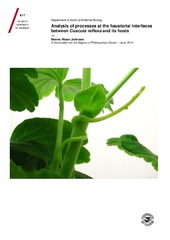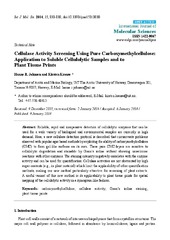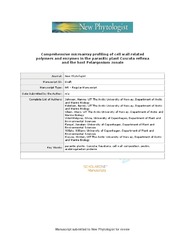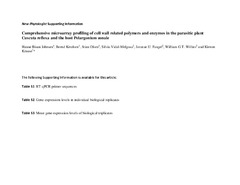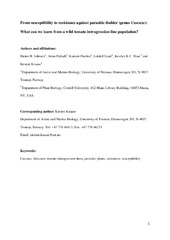| dc.contributor.advisor | Krause, Kirsten | |
| dc.contributor.author | Johnsen, Hanne Risan | |
| dc.date.accessioned | 2016-04-18T09:06:49Z | |
| dc.date.available | 2016-04-18T09:06:49Z | |
| dc.date.issued | 2014-08-27 | |
| dc.description.abstract | The genus Cuscuta comprises a group of holoparasitic dicotyledonous angiosperms that cause damage to many economically important crops. Parasitic plants form physical and physiological connections (haustoria) with the parenchyma and vascular vessels of compatible host plants. These connections provide them with water, mineral nutrients and organic compounds. Over time, this life style has led to evolutionary adaptations that include a reduction or loss of leaves and roots and the inability to live photoautotrophically. The penetration of host plants by Cuscuta is believed to rely on mechanical pressure applied to the cells of the host and on the secretion of hydrolytic, cell-wall degrading enzymes.
Despite the ecological and economic significance of the genus Cuscuta, the mechanisms behind its attack and the corresponding reactions observed in susceptible and resistant host plants remain largely unknown. The goal of this thesis has been to broaden the understanding of the processes unfolding during the interaction between this parasite and its hosts. This knowledge is, among others, crucial to evaluate the biotechnological potential of Cuscuta–derived enzymes. To reach this goal, established biochemical, immunohistological and genetic approaches were exploited, where possible. However, in some cases the established techniques failed for Cuscuta so that new approaches had to be devised.
The work focused on one hand on the proteins involved in the infection process and on the other hand on the cell wall polysaccharides that are substrates to the hydrolytic secreted enzymes. An improved method for the reliable detection of cellulase activity in plant extracts and in tissue prints was developed and confirmed the high cellulolytic activity exhibited by the parasite. With a combination of high throughput and high resolution approaches, we succeeded furthermore in profiling cell wall components as well as CAZyme activities in situ. Finally, the investigation of a tomato introgression line population which exhibited differences in susceptibility to C. reflexa will give new impulses in the quest to elucidate the genetic and molecular background for susceptibility to C. reflexa in compatible species. | en_US |
| dc.description.doctoraltype | ph.d. | en_US |
| dc.description.popularabstract | Cuscuta representerer en familie parasittiske planter som forårsaker stor ødeleggelse av mange nytte- og matplanter. På grunn av manglende røtter og svært reduserte blader er Cuscuta avhengig av å penetrere vertsplanter og etablere modifiserte røtter (haustoria) hvor de tar opp vann og næring fra vertsplantens ledningsvev. Til tross for stor økologisk og økonomisk relevans, er det fortsatt ikke påvist hvilke mekanismer som er involvert i invaderingen av vertsplanter eller reaksjonene observert i mottakelige og resistente vertsplanter. Målet med denne oppgaven har vært å belyse interaksjonene som foregår mellom Cuscuta og dens vertsplanter under infeksjonsprosessen. Vi har benyttet etablerte biokjemiske og genetiske metoder i tillegg til at vi har vært nødt til å etablere nye metoder. Ved å bruke en kombinasjon av metoder med høy produktivitet og høy oppløsning har vi lykkes i å studere celleveggkomponenter og cellevegg-aktive enzymer i Cuscuta og dens vertsplanter. Vi har videre etablert et system som kan bidra i arbeidet med å kartlegge det genetiske og molekylære grunnlaget for resistens i vertsplanter. | en_US |
| dc.description.sponsorship | Tromsø forskningsstiftelse, publikasjonsfondet (UiT), COST Short term scientific mission, Grønn Fases Energipris 2010 | en_US |
| dc.identifier.isbn | 8266-085-3 | |
| dc.identifier.uri | https://hdl.handle.net/10037/9124 | |
| dc.identifier.urn | URN:NBN:no-uit_munin_8687 | |
| dc.language.iso | eng | en_US |
| dc.publisher | UiT The Arctic University of Norway | en_US |
| dc.publisher | UiT Norges arktiske universitet | en_US |
| dc.rights.accessRights | openAccess | |
| dc.rights.holder | Copyright 2014 The Author(s) | |
| dc.rights.uri | https://creativecommons.org/licenses/by-nc-sa/3.0 | en_US |
| dc.rights | Attribution-NonCommercial-ShareAlike 3.0 Unported (CC BY-NC-SA 3.0) | en_US |
| dc.subject | VDP::Mathematics and natural science: 400::Basic biosciences: 470::Molecular biology: 473 | en_US |
| dc.subject | VDP::Matematikk og Naturvitenskap: 400::Basale biofag: 470::Molekylærbiologi: 473 | en_US |
| dc.subject | VDP::Mathematics and natural science: 400::Basic biosciences: 470::Genetics and genomics: 474 | en_US |
| dc.subject | VDP::Matematikk og Naturvitenskap: 400::Basale biofag: 470::Genetikk og genomikk: 474 | en_US |
| dc.subject | VDP::Mathematics and natural science: 400::Basic biosciences: 470::Biochemistry: 476 | en_US |
| dc.subject | VDP::Matematikk og Naturvitenskap: 400::Basale biofag: 470::Biokjemi: 476 | en_US |
| dc.title | Analysis of processes at the haustorial interfaces between Cuscuta reflexa and its hosts | en_US |
| dc.type | Doctoral thesis | en_US |
| dc.type | Doktorgradsavhandling | en_US |


 English
English norsk
norsk